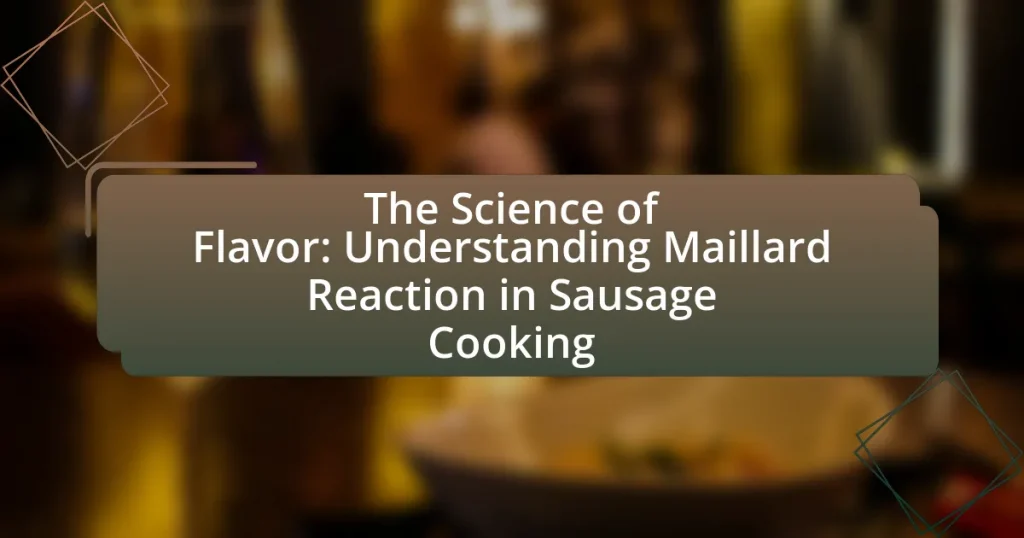The article focuses on the Maillard Reaction, a critical chemical process in sausage cooking that enhances flavor, aroma, and color through the interaction of proteins and sugars at elevated temperatures. It details how this reaction contributes to the development of complex flavor compounds and the desirable browning of cooked sausages, emphasizing the importance of temperature, moisture content, and ingredient selection. Additionally, the article explores practical cooking techniques and common mistakes to avoid, providing insights into optimizing the Maillard Reaction for improved taste and texture in sausage preparation.

What is the Maillard Reaction in Sausage Cooking?
The Maillard Reaction in sausage cooking is a complex chemical process that occurs when proteins and sugars in the meat react under heat, resulting in the development of rich flavors and a brown color. This reaction typically begins at temperatures above 140°C (284°F) and is crucial for enhancing the taste and aroma of cooked sausages. The Maillard Reaction not only contributes to the savory flavor profile but also creates appealing visual characteristics, making the sausage more appetizing.
How does the Maillard Reaction contribute to flavor development?
The Maillard Reaction significantly contributes to flavor development by creating complex flavor compounds through the reaction between amino acids and reducing sugars during cooking. This chemical process occurs at elevated temperatures, typically above 140°C (284°F), resulting in the formation of hundreds of different flavor compounds that enhance the taste and aroma of cooked foods, particularly in meats like sausage. Research indicates that these compounds include various aldehydes, ketones, and pyrazines, which are responsible for the rich, savory flavors associated with grilled or roasted meats. The Maillard Reaction not only improves flavor but also contributes to the desirable browning and texture of the food, making it a crucial aspect of culinary science.
What are the chemical processes involved in the Maillard Reaction?
The Maillard Reaction involves a series of complex chemical processes primarily between reducing sugars and amino acids, leading to the formation of a wide range of flavor compounds and brown pigments known as melanoidins. Initially, a reducing sugar reacts with an amino acid to form a glycosylamine through a condensation reaction. This intermediate undergoes rearrangement to produce an Amadori compound, which can further dehydrate and undergo various reactions, including fragmentation and polymerization, resulting in the diverse flavors and aromas characteristic of cooked foods. The reaction is influenced by factors such as temperature, pH, and moisture content, with optimal conditions typically occurring between 140°C and 165°C.
How does temperature influence the Maillard Reaction in sausage?
Temperature significantly influences the Maillard Reaction in sausage by accelerating the rate of browning and flavor development. As temperature increases, the reaction between amino acids and reducing sugars occurs more rapidly, leading to the formation of complex flavors and aromas that enhance the sausage’s taste. Specifically, optimal temperatures for the Maillard Reaction typically range from 140°C to 165°C (284°F to 329°F), where the reaction is most efficient. At these temperatures, the production of desirable compounds such as melanoidins, which contribute to color and flavor, is maximized. Conversely, temperatures below this range can slow the reaction, resulting in less flavor complexity and a paler appearance in the sausage.
Why is the Maillard Reaction important in culinary practices?
The Maillard Reaction is important in culinary practices because it enhances flavor, aroma, and color in cooked foods. This complex chemical reaction occurs between amino acids and reducing sugars when food is heated, resulting in the development of rich, savory flavors and appealing browning. For example, the browning of meat during cooking not only improves its visual appeal but also creates a depth of flavor that is essential in dishes like sausages. Studies have shown that the Maillard Reaction contributes significantly to the overall sensory experience of food, making it a crucial element in culinary techniques.
What flavors are enhanced by the Maillard Reaction in sausage?
The Maillard Reaction enhances savory, umami, and roasted flavors in sausage. This complex chemical reaction occurs between amino acids and reducing sugars when sausage is cooked at high temperatures, resulting in the development of rich, complex flavors and aromas. Studies have shown that the Maillard Reaction contributes to the browning and flavor profile of cooked meats, making them more appealing and palatable.
How does the Maillard Reaction affect the texture of cooked sausage?
The Maillard Reaction significantly enhances the texture of cooked sausage by creating a complex network of proteins and sugars that contribute to browning and flavor development. This reaction occurs when amino acids and reducing sugars react under heat, leading to the formation of new compounds that improve the mouthfeel and overall sensory experience of the sausage. Specifically, the Maillard Reaction increases the firmness and juiciness of the sausage, as it helps to retain moisture during cooking. Studies have shown that sausages cooked at higher temperatures exhibit a more pronounced Maillard Reaction, resulting in a desirable crispy exterior and a tender interior, which are key attributes of well-cooked sausage.

What factors influence the Maillard Reaction in sausage cooking?
The Maillard Reaction in sausage cooking is influenced by several key factors, including temperature, pH, moisture content, and the presence of reducing sugars and amino acids. High temperatures, typically above 140°C (284°F), accelerate the reaction, leading to browning and flavor development. A higher pH level enhances the reaction rate, while moisture content must be balanced; too much moisture can inhibit the reaction, whereas too little can promote it. Additionally, the presence of reducing sugars and amino acids, which are the building blocks of proteins, is essential for the formation of complex flavors and aromas during the cooking process.
How do ingredients affect the Maillard Reaction?
Ingredients significantly influence the Maillard Reaction by providing the necessary amino acids and reducing sugars that initiate and drive the reaction. The presence of specific amino acids, such as lysine and proline, enhances the formation of flavor compounds and browning, while varying sugar types, like glucose and fructose, can affect the rate and intensity of the reaction. For instance, research indicates that higher concentrations of reducing sugars lead to more pronounced browning and complex flavor development, as seen in studies on grilled meats where the Maillard Reaction is critical for flavor enhancement.
What role do sugars and amino acids play in the reaction?
Sugars and amino acids are essential reactants in the Maillard reaction, which is a complex chemical process that occurs during the cooking of sausage, contributing to flavor and color development. In this reaction, reducing sugars react with amino acids to form a variety of flavor compounds and brown pigments known as melanoidins. This interaction not only enhances the savory and sweet notes in the sausage but also creates a desirable brown crust, which is a hallmark of well-cooked meat products. The Maillard reaction typically occurs at elevated temperatures, around 140 to 165 degrees Celsius, and is influenced by factors such as pH and moisture content, further underscoring the critical roles that sugars and amino acids play in flavor enhancement during cooking.
How does moisture content impact the Maillard Reaction?
Moisture content significantly impacts the Maillard Reaction by influencing the rate and extent of browning in food. Higher moisture levels can slow down the reaction because water competes with the reactants for heat, which is essential for the reaction to occur. Conversely, lower moisture levels facilitate a more rapid Maillard Reaction, leading to enhanced browning and flavor development. Research indicates that optimal moisture levels, typically around 20-30%, promote the best flavor and color outcomes in cooked meats, as demonstrated in studies on grilled and roasted products.
What cooking methods enhance the Maillard Reaction in sausage?
High-heat cooking methods such as grilling, pan-searing, and roasting enhance the Maillard Reaction in sausage. These methods promote the necessary temperature range of 300°F to 500°F (150°C to 260°C) that facilitates the complex chemical reactions between amino acids and reducing sugars, resulting in the desirable browning and flavor development. For instance, grilling exposes sausage to direct heat, allowing for rapid surface browning, while pan-searing creates a crust through contact with a hot surface, both of which intensify the Maillard Reaction.
How does grilling compare to frying in promoting the Maillard Reaction?
Grilling promotes the Maillard Reaction more effectively than frying due to higher temperatures and direct exposure to heat. Grilling typically reaches temperatures above 500°F, which accelerates the reaction between amino acids and reducing sugars, resulting in enhanced browning and flavor development. In contrast, frying usually occurs at lower temperatures, around 350°F to 375°F, which can limit the extent of the Maillard Reaction. Studies indicate that the intense heat from grilling not only facilitates the reaction but also contributes to the formation of complex flavor compounds, making grilled foods often more flavorful than their fried counterparts.
What techniques can be used to optimize the Maillard Reaction during cooking?
To optimize the Maillard Reaction during cooking, techniques such as controlling temperature, adjusting pH, and managing moisture levels can be employed. High temperatures, typically above 140°C (284°F), accelerate the reaction, enhancing browning and flavor development. Additionally, increasing the pH through the use of alkaline ingredients, like baking soda, can promote the reaction, as it favors the formation of flavor compounds. Reducing moisture content by using dry heat methods, such as roasting or grilling, also aids in achieving the desired browning, as excess moisture can inhibit the reaction. These techniques are supported by culinary science, which emphasizes the importance of heat and chemical conditions in flavor enhancement through the Maillard Reaction.

How can one achieve the best flavor through the Maillard Reaction in sausage cooking?
To achieve the best flavor through the Maillard Reaction in sausage cooking, one should ensure that the sausage is cooked at a high temperature and has a sufficient amount of protein and sugar present. The Maillard Reaction occurs when amino acids and reducing sugars react under heat, creating complex flavors and browning. Cooking sausages at temperatures above 300°F (150°C) promotes this reaction, enhancing the savory and rich flavors characteristic of well-cooked sausage. Additionally, using ingredients like spices and marinades that contain sugars can further facilitate the Maillard Reaction, leading to a more flavorful end product.
What are the best practices for maximizing flavor in sausage?
To maximize flavor in sausage, use high-quality meat and a balanced blend of spices. High-quality meat enhances the overall taste, while a well-thought-out spice mix, including salt, pepper, garlic, and herbs, contributes to depth and complexity. Additionally, incorporating fat, such as pork fat or beef tallow, ensures moisture and richness, which are essential for flavor development.
The Maillard reaction, which occurs during cooking, is crucial for flavor enhancement; it happens when proteins and sugars react under heat, creating complex flavors and aromas. Cooking sausages at the right temperature, typically between 160°F to 180°F, allows for optimal Maillard reaction without drying out the meat.
Furthermore, allowing sausages to rest after cooking helps redistribute juices, enhancing flavor retention. These practices collectively ensure that the sausage is flavorful and enjoyable.
How can seasoning and marinating influence the Maillard Reaction?
Seasoning and marinating can significantly enhance the Maillard Reaction by introducing various compounds that promote browning and flavor development. Seasonings, such as salt and spices, can alter the pH and moisture content of the meat, which are critical factors in facilitating the Maillard Reaction. For instance, salt can draw out moisture, concentrating the proteins and sugars that react during cooking, while spices can provide additional amino acids and sugars that contribute to the reaction.
Marinating, on the other hand, often involves acidic components like vinegar or citrus juice, which can also affect the pH and tenderize the meat, making it more conducive to the Maillard Reaction. Research indicates that marinades containing sugars can enhance the browning effect, as sugars are essential reactants in the Maillard process. Therefore, both seasoning and marinating not only influence the flavor profile but also optimize the conditions for the Maillard Reaction to occur, resulting in a more flavorful and visually appealing product.
What temperature ranges are ideal for achieving optimal flavor?
The ideal temperature range for achieving optimal flavor in sausage cooking is between 300°F to 500°F (149°C to 260°C). This temperature range facilitates the Maillard reaction, which is crucial for developing complex flavors and aromas in cooked meats. Research indicates that the Maillard reaction begins at around 285°F (140°C) and intensifies as temperatures rise, leading to the formation of desirable flavor compounds. Therefore, maintaining temperatures within this range is essential for enhancing the overall taste profile of sausages.
What common mistakes should be avoided when cooking sausage?
Common mistakes to avoid when cooking sausage include cooking at too high a temperature, which can lead to burnt exteriors and undercooked interiors. Sausages should be cooked over medium heat to allow for even cooking and proper development of the Maillard reaction, which enhances flavor. Another mistake is not using a meat thermometer; sausages should reach an internal temperature of 160°F (71°C) for safety and optimal taste. Additionally, overcrowding the pan can trap steam, preventing browning and flavor development. Lastly, not allowing sausages to rest after cooking can result in loss of juices, affecting texture and flavor.
How can overcooking affect the Maillard Reaction and flavor?
Overcooking can inhibit the Maillard Reaction and negatively impact flavor by causing excessive browning and the formation of bitter compounds. The Maillard Reaction, which occurs between amino acids and reducing sugars, is responsible for the desirable flavors and aromas in cooked foods. When food is overcooked, the reaction can progress beyond optimal levels, leading to the breakdown of flavor compounds and the creation of undesirable tastes. Studies indicate that prolonged cooking times can result in the loss of volatile flavor compounds, which are crucial for the overall sensory experience of the dish.
What are the signs of undercooking in relation to the Maillard Reaction?
The signs of undercooking in relation to the Maillard Reaction include a lack of browning on the surface of the meat, which indicates insufficient temperature and time for the reaction to occur. When the Maillard Reaction is properly executed, it produces a desirable brown color and complex flavors; therefore, if the sausage remains pale or has a rubbery texture, it suggests that the cooking process has not reached the necessary conditions for the reaction. Additionally, the absence of a crust or sear on the exterior further confirms undercooking, as the Maillard Reaction typically creates a flavorful crust that enhances taste and aroma.
What practical tips can enhance the Maillard Reaction in sausage cooking?
To enhance the Maillard Reaction in sausage cooking, use higher cooking temperatures, ensure the sausage surface is dry, and incorporate sugars. Higher temperatures, typically above 300°F (150°C), promote the reaction, leading to browning and flavor development. Drying the sausage surface before cooking prevents steam, which can inhibit browning. Additionally, adding sugars, such as honey or brown sugar, can accelerate the Maillard Reaction by providing more reactants for the process. These methods are supported by culinary science, which indicates that optimal conditions for the Maillard Reaction significantly improve flavor and color in cooked meats.
